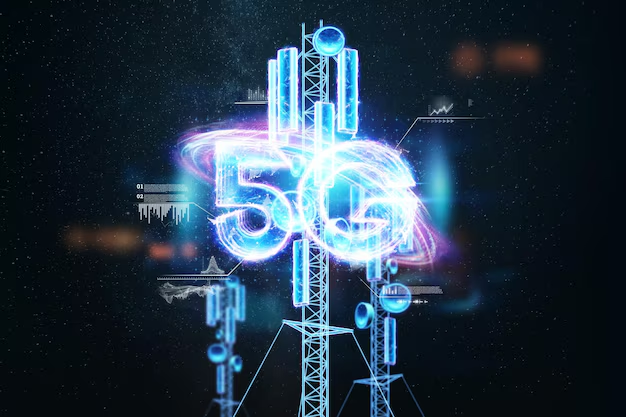
When Mike first heard about what 5G had to offer for industrial IoT, he was skeptical. His refinery had already invested a lot in sensors and automation. Sure, the systems that existed weren’t great—slow at times, and still a hassle to watch everything from energy usage to machinery. Would a new networking technology actually change all of that? Fast-forward three years, and Mike’s refinery is not only running smoothly—it’s a whole different beast. With the implementation of 5G-based Industrial IoT solutions, he now has real-time visibility into all aspects of the refinery operation, from the process of extracting oil to refinery bottlenecks. His company, and hundreds more like it, have been revolutionized.
5G Industrial IoT Revolution: A Revolution Like No Other
Industrial Internet of Things (IIoT) technology has powered energy, manufacturing, and processing industries for years. They are connected devices exchanging data in order to help to streamline processes, optimize them, and minimize downtime.
But up until now, numerous IIoT systems were held back by data speed, network latency, and reliability limits.
5G is flipping that on its head, and it’s not just about speed. McKinsey puts the figure at up to a 20% increase in operational efficiency for industrial stakeholders that leverage IIoT by 2030. That’s a ginormous number, particularly when we are talking about companies like oil refineries or production houses that deal with ginormous data volumes, advanced machinery, and dangerous processes.
Let’s dig deeper into just how 5G is disrupting IIoT for companies in general, looking at edible oil refinery manufacturers and other companies that operate based on real-time information and processing as examples.
5G’s Top Features That Power IoT Systems
In order to appreciate why 5G is an absolute game-changer, you need to understand what makes it stand out compared to its predecessor.
Ultra-Low Latency
The low latency of 5G (around 1 millisecond) is perhaps one of the biggest upgrades from 4G. In industrial use cases such as edible oil extraction plants, where equipment is operating in real-time, delay can be the difference between efficient operation and an expensive mistake. Consider, for instance, a refinery that depends on IIoT sensors to track pressure and temperature levels. With 5G, the sensors can now send data almost in real-time, enabling operators to make hair-splitting decisions.
Massive Data Transport with Large Bandwidth
5G offers far more bandwidth than 4G. This comes in handy with industrial settings featuring thousands of sensors and devices transmitting data at once. Whether it is a smart factory or an oil refinery, being able to handle large amounts of data seamlessly means improved analytics, faster response, and higher productivity. For edible oil refinery manufacturers, this means improved monitoring of production processes and higher yields.
Increased Device Density
With 5G, industries can support up to one million devices per square kilometer. This is essential for huge industrial IoT systems where hundreds or thousands of devices need to communicate at the same time. In an edible oil factory, this would mean that every equipment ranging from refining machines to storage tanks would be linked to a single system that controls and monitors everything in real-time.
Enhanced Reliability
Industrial environments require bulletproof network reliability. Interruptions lead to downtime, costly repair, or even safety risks. With the 99.999% reliability of 5G, oil and gas extraction industries are able to have day-and-night operations with no fear of unexpected communication breakdowns among their IoT equipment.
Real-World Applications: 5G and Edible Oil Refineries
To refinery producers of edible oil, 5G as part of their IIoT infrastructure is a breakthrough. Here’s why:
Automated Process Control
Refineries are multi-step operations, with many steps of extraction, refining, and delivery to be tracked at all times. 5G makes process control in real-time a breeze. Sensors at each point of the refinery can provide real-time information regarding the quality of crude oil, flow rates, and equipment health, which can be changed on the fly by the operators. You can find out how refineries are using 5G to facilitate them to automate.
For edible oil extraction plants manufacturers, this means less idle time in manufacturing and greater efficiency. If any section of the plant is not operating at full capacity, the IIoT system can adapt the rest of the plant to compensate automatically without wasting time.
Predictive Maintenance
Another advantage of 5G in IIoT equipment is the potential for predictive maintenance. AI-based systems and sensors can forecast when the equipment is going to fail or need maintenance. For instance, at an edible oil refinery, if refining equipment is already developing premature wear and tear, the IIoT system can alert for preventive action before the situation spirals out of control. This prevents manufacturers from paying for costly breakdowns and keeps the factory running smoothly like a well-oiled machine.
According to a Capgemini report in 2019, predictive maintenance with IoT-enabled systems can cut downtime by as much as 50%. With the 5G benefit, these systems can now respond with near-instant response times, so machinery is always operating at peak levels.
Energy Management and Sustainability
Energy consumption is the most significant issue for edible oil extraction plants and refineries. With the advent of 5G, these plants can monitor energy consumption in the process. Using real-time data, IIoT solutions automatically optimize the process and save energy, making the plant environment-friendly.
This is particularly significant given that industries everywhere in the world are experiencing growing pressure to minimize carbon impressions. For food oil refinery plant manufacturers, embracing IIoT driven by 5G can be a point of make-or-break for them, enabling them to meet the goals of energy efficiency without diminishing the quality of production.
Forward, 5G isn’t a trend—it’s the future of industrial automation. From pipeline-scanning drones for oil to robots on factory floors, the applications are endless. 5G’s high-reliability, high-speed, low-latency network will be the foundation that supports them.
Collaborative Robotics (Cobots)
Cobots are cobot robots that co-exist and cooperate with employees in an enterprise to increase efficiency. Oil plant cobots and other manufacturing industry cobots using 5G are able to cooperate more swiftly and accurately. Cobots in a refinery can conduct monotonous operations or hazardous ones like equipment loading and unloading, and employee personnel undertake sophisticated operations.
Integrating AI and Machine Learning
5G will also make it simpler to embed machine learning and AI in IIoT platforms. Through the instant processing of enormous amounts of data, AI applications are able to pick out trends that are difficult for people to identify, further automating industrial processes.
For edible oil refiners companies, this means intelligent production lines that learn and adjust in real-time, with the highest quality product, and minimizing waste.
Challenges and Considerations
While the advantages of 5G to IIoT are obvious, it is not without its drawbacks. One is the cost of bringing existing systems up to 5G, for example, to smaller operations. Another is security—more devices online means more potential vulnerabilities to be broken into. Companies need to get ahead of defending their networks and their IIoT systems from vulnerability.
Conclusion: The Future is 5G
As companies all over the world become more connected and automated, 5G will be the force behind making that happen. For companies such as edible oil refinery makers and extraction facilities, 5G isn’t merely an upgrade in technology—it’s a revolution in the way they function, monitor, and manage their operations.
Mike’s refinery? Oh, he’s turned into a 5G champion. Real-time monitoring, energy efficiency, and predictive maintenance have turned him from a skeptic into a convert. And the more industries transition to this future-proof technology, the more the question now is: Are you ready to jump to 5G-driven industrial IoT systems?








